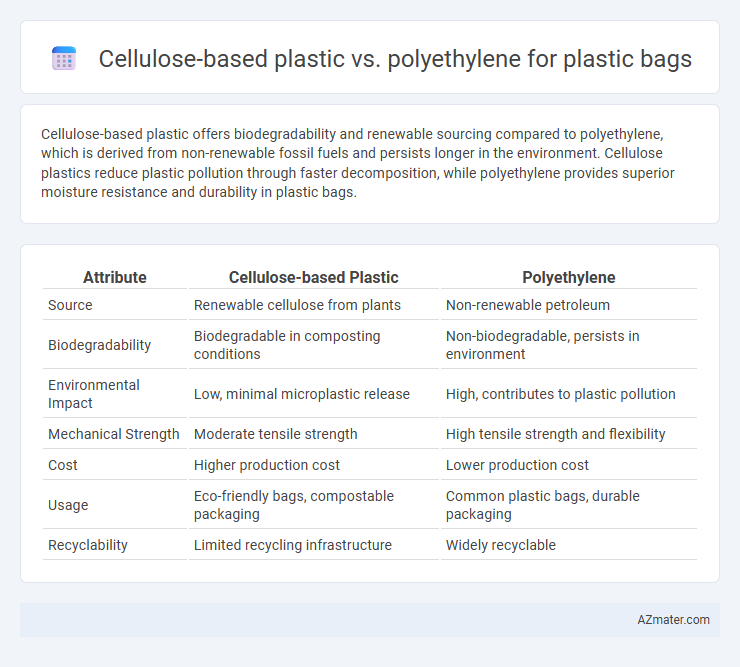Cellulose-based plastic offers biodegradability and renewable sourcing compared to polyethylene, which is derived from non-renewable fossil fuels and persists longer in the environment. Cellulose plastics reduce plastic pollution through faster decomposition, while polyethylene provides superior moisture resistance and durability in plastic bags.
Table of Comparison
| Attribute | Cellulose-based Plastic | Polyethylene |
|---|---|---|
| Source | Renewable cellulose from plants | Non-renewable petroleum |
| Biodegradability | Biodegradable in composting conditions | Non-biodegradable, persists in environment |
| Environmental Impact | Low, minimal microplastic release | High, contributes to plastic pollution |
| Mechanical Strength | Moderate tensile strength | High tensile strength and flexibility |
| Cost | Higher production cost | Lower production cost |
| Usage | Eco-friendly bags, compostable packaging | Common plastic bags, durable packaging |
| Recyclability | Limited recycling infrastructure | Widely recyclable |
Introduction to Cellulose-Based Plastics and Polyethylene
Cellulose-based plastics, derived from natural cellulose fibers found in plants, offer a biodegradable and renewable alternative to traditional plastics. Polyethylene, a widely used synthetic polymer derived from petroleum, dominates plastic bag production due to its durability and low cost. Comparing cellulose-based plastics and polyethylene highlights key differences in environmental impact, biodegradability, and material sources.
Environmental Impact: Biodegradability and Pollution
Cellulose-based plastics offer superior biodegradability compared to polyethylene, breaking down naturally within months under composting conditions, significantly reducing long-term pollution. Polyethylene bags persist in the environment for hundreds of years, contributing to microplastic pollution and harming marine and terrestrial ecosystems. The cellulose composition originates from renewable plant materials, further minimizing environmental footprint compared to fossil fuel-derived polyethylene.
Raw Materials and Production Processes
Cellulose-based plastics are derived from renewable plant fibers such as wood pulp or cotton linters, utilizing a biochemical process that involves dissolving cellulose and regenerating it into a biodegradable polymer. Polyethylene, extracted from non-renewable fossil fuels, undergoes polymerization of ethylene monomers in a chemical process that produces a durable, non-biodegradable thermoplastic. The cellulose-based option benefits from sustainable raw materials and lower environmental impact during production, whereas polyethylene relies on petrochemical extraction and energy-intensive manufacturing methods.
Durability and Performance in Plastic Bags
Cellulose-based plastic bags exhibit moderate durability with natural biodegradability, but they tend to have lower tensile strength and moisture resistance compared to polyethylene bags. Polyethylene, especially high-density polyethylene (HDPE), offers superior durability, flexibility, and resistance to tearing, making it a preferred choice for heavy-duty plastic bags. Performance-wise, polyethylene maintains integrity under varying environmental conditions, whereas cellulose-based plastics may degrade more rapidly when exposed to moisture and mechanical stress.
Cost-Effectiveness and Market Availability
Cellulose-based plastics typically have higher production costs compared to polyethylene, making them less cost-effective for large-scale plastic bag manufacturing. Polyethylene dominates the market due to its low price, abundance of raw materials, and established production infrastructure. Despite cellulose-based options offering biodegradability, their limited market availability and higher price point restrict widespread adoption.
Life Cycle Assessment and Carbon Footprint
Life Cycle Assessment (LCA) reveals cellulose-based plastics generally exhibit lower carbon footprints than polyethylene bags due to renewable raw materials and biodegradability. Cellulose bags, derived from plant fibers, reduce fossil fuel dependence and often biodegrade in industrial composting, minimizing environmental impact. In contrast, polyethylene bags, made from non-renewable petroleum, contribute significant greenhouse gas emissions throughout production and persist in landfills, increasing long-term ecological harm.
Consumer Perception and Usage Trends
Consumers increasingly favor cellulose-based plastics for bags due to their biodegradability and reduced environmental impact compared to polyethylene, which is criticized for contributing to plastic pollution. Cellulose-based bags appeal to eco-conscious users seeking sustainable alternatives, while polyethylene remains dominant due to its durability, cost-effectiveness, and widespread availability. Market trends indicate a gradual rise in cellulose-based plastic adoption driven by growing regulatory pressures and consumer demand for green packaging solutions.
Regulatory Frameworks and Industry Standards
Cellulose-based plastics for bags comply with stringent biodegradable and compostability standards such as ASTM D6400 and EN 13432, positioning them favorably under emerging global regulations targeting single-use plastics. Polyethylene bags remain subject to extensive regulatory scrutiny, including restrictions under the European Union's Single-Use Plastics Directive and various municipal bans due to their persistence in the environment. Industry standards for cellulose plastics emphasize eco-certifications and life cycle assessments, whereas polyethylene standards focus on recyclability protocols and waste management infrastructure compatibility.
Challenges in Large-Scale Adoption
Cellulose-based plastics face challenges in large-scale adoption due to higher production costs and limited industrial processing infrastructure compared to polyethylene, which benefits from decades of established manufacturing and supply chains. Biodegradability of cellulose-based plastics requires specific composting conditions that are not universally available, reducing their environmental advantage in conventional waste management systems. Scaling cellulose-based plastic production also demands significant raw material inputs, potentially impacting land use and competing with food crops, whereas polyethylene relies on abundant fossil fuel feedstocks.
Future Prospects and Innovations in Sustainable Packaging
Cellulose-based plastic offers promising future prospects in sustainable packaging due to its biodegradability and renewable origin, reducing reliance on fossil fuels compared to polyethylene, which is predominantly derived from non-renewable petroleum sources. Innovations in enhancing the mechanical strength and moisture resistance of cellulose-based plastics aim to match the durability and flexibility of polyethylene bags while ensuring rapid decomposition in natural environments. Advances in bioengineering and nanotechnology further enable the development of hybrid cellulose-polyethylene composites that optimize environmental benefits without compromising performance in plastic bag applications.

Infographic: Cellulose-based plastic vs Polyethylene for Plastic bag
 azmater.com
azmater.com